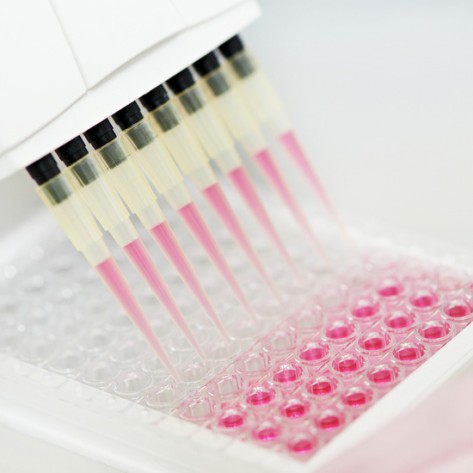Your cart is currently empty!
Human Programmed Death-1 (PD-1) ELISA Kit
Human Programmed Death-1 (PD-1) ELISA KitFor the Quantitative Determination of Human Programmed Death-1 (PD-1) Concentrations in Cell Culture Supernatant and Other Biological Samples.For Laboratory Research Use Only.
Description
|
RACTIVITY |
Human |
|
SENSITIVITY |
0.44 pg/mL |
|
ASSAY RANGE |
15.6 – 1000 pg/mL |
|
REAGENTS PROVIDED |
Anti PD-1 COATED MICROTITER PLATE |
INTENDED USE
This human PD-1 ELISA kit is to be used for the in vitro quantitative determination of human Programmed Death-1(PD-1) concentrations in cell culture supernatant and other biological fluids. This kit is intended for LABORATORY RESEARCH USE ONLY
INTRODUCTION
Programmed Cell Death-1 (PD-1) is a receptor that is elevated on activated T cells, B cells and macrophages. PD-1 is a checkpoint co-inhibitor of T cell-associated immune response. When T cell receptor (TCR) engages with the foreign/cancer antigen, PD-1 is joined with its ligand, programmed death ligand-1 (PD-L1) on the antigen presenting cells simultaneously and triggers an inhibitory signal to suppress IL-2 production and antigen specific CD8+ T-cell proliferation. In addition, PD-1/PDL-1 binding promotes regulatory T cells (Tregs) development and function. PD-L1 is expressed abundantly in immune-privileged organs such as placenta, eyes and testes and plays a role in tolerance. Upregulation of PD-L1 has been found in many cancer types, such as bladder cancer, non-small cell lung cancer (NSCLC), renal cancer, melanoma, ovarian cancer, and breast cancer. Evidences showed that the PD-1/PD-L1 pathway is associated with autoimmunity, cancer’s immune evasion, the antigen-specific CD4+ T cell exhaustion during some chronic infection, and neurodegeneration in Alzheimer’s disease.
PD-L2, another ligand of PD-1, is mainly expressed in macrophages and dendritic cells and has a low constitutive basal expression. PD-L2 plays a role in modulation of Th2 type of immune response, while PD-L1 is an important negative regulator to Th1 response which is more relevant to cancer immunity.
Soluble PD-1 (sPD-1) can be detected in blood. Increased sPD-1 expression is associated with autoimmunity and with the systemic inflammatory condition in cancer patients. Characterization of sPD-1 in aplastic anemia patients revealed that it is an alternative slice variant of PD-1, which lacks the transmembrane domain. Evidences suggest that sPD-1 may upregulate T cell immunity by blocking the binding of membrane PD-1 with its ligands. It has been observed that increased sPD-1 is correlated with better prognosis in erlotinib treated advanced EGFR-mutated non-small cell lung cancer patients.The PD-1 ELISA kit is for measurement of PD-1 in cell culture and other biological samples. The kit is for research only. The detected value of PD-1 can only be used as reference for scientific study. The kit should not be used in any diagnostic or therapeutic procedures.
PRINCIPLE OF THE ASSAY
This enzyme-linked immunosorbent assay (ELISA) applies a technique called a quantitative sandwich immunoassay. The microtiter plate provided in this kit has been pre-coated with a monoclonal antibody specific for human PD-1. When standards or samples are added to the appropriate microtiter plate wells, human PD-1 in the standards or samples will be immobilized by the pre-coated antibody during incubation. A biotin-conjugated antibody preparation specific for human PD-1 is added to each well and incubated. The biotin labelled antibody attaches to the wells by binding to human PD-1. After plate washing, other proteins, components and unattached biotin labelled antibody is removed. Then, avidin-horseradish peroxidase (HRP) conjugate is added to each well. Avidin has a very high affinity for biotin, thus, it links the tracer (HRP) sturdily to the biotin labelled antibody. The wells are thoroughly washed to remove all unbound avidin-HRP conjugate and a TMB (3,3’,5,5′ tetramethyl-benzidine) substrate solution is added to each well. The enzyme (HRP) and substrate are allowed to react over a short incubation period. Only wells that contain human PD-1 will exhibit a change in colour. The extent of colour change is proportional to the quantity of human PD-1 presented in the standards/samples. The enzyme-substrate reaction is terminated by the addition of a sulphuric acid solution and the colour change is measured spectrophotometrically at a wave length of 450 nm ± 2 nm. According to the testing system, the provided standard is serial diluted (2-fold) with the appropriate diluent and assayed at the same time as the samples. This allows the operator to produce a curve of Optical Density (O.D.) versus human PD-1 concentration (pg/mL) in standards. The concentration of human PD-1 in the samples is then determined by comparing the O.D. of the samples to the standard curve and multiplying with sample dilution factor.


Reviews
There are no reviews yet.